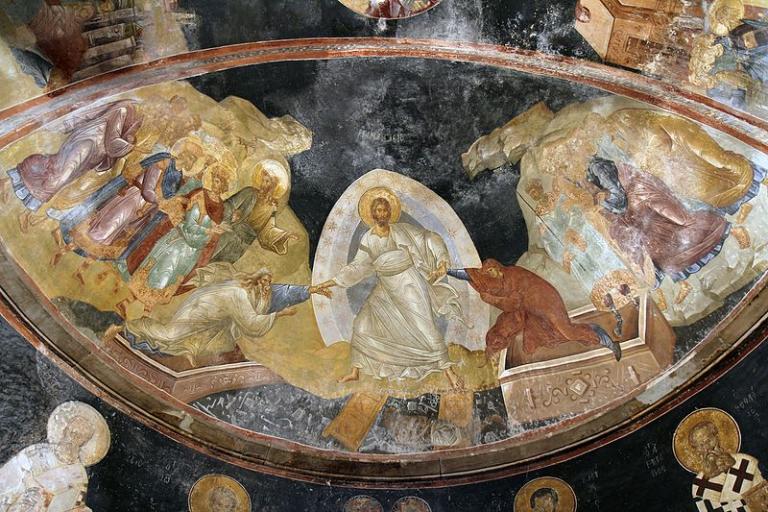
(Wikimedia Commons public domain image)
***
The new article that went up today in Interpreter: A Journal of Latter-day Saint Faith and Scholarship is our annual Easter article — though, for reasons that I fully understand and with which I can sympathize, its author, Claudia Bushman, is not overly fond of that word, Easter:
Abstract: We tend to have big events and a full month celebrating Christmas, but here we are in a very Christian church that has come to almost ignore the events of the crucifixion and the resurrection. The Last Supper and the events that followed it are the important events of the season. With some planning and creativity, we can immerse ourselves in a Resurrection Month by thinking about the gift of life and promise for the future that we have been given, reading the old scriptures, and reliving the life and times of our elder brother and great teacher.
***
A reader of this blog named Nathan Whilk has kindly reminded me of the epitaph for Joy Davidman, C. S. Lewis’s American-born wife. It’s wonderfully appropriate for this season of the year:
Here the whole world (stars, water, air,
And field, and forest, as they were
Reflected in a single mind)
Like cast off clothes was left behind
In ashes, yet with hopes that she,
Re-born from holy poverty,
In lenten lands, hereafter may
Resume them on her Easter Day.
***
A. Keith Thompson, “The Doctrine of Resurrection in the Book of Mormon”
Abstract: The doctrine of resurrection was taught by Lehi and Jacob among the first Nephites but was not mentioned again in the record until the time of Abinadi, perhaps 350 years later. In the court of King Noah that doctrine and the idea of a suffering Messiah who would bear the sins of his people and redeem them, were heresies and Abinadi paid for them with his life. While Abinadi’s testimony converted Alma1 and the doctrine of the resurrection inspired Alma2 after his conversion, it was a source of schism in the church at Zarahemla along lines that remind us of the Sadducees at Jerusalem. The doctrine of the resurrection taught in the Book of Mormon is a precursor to the doctrine now understood by the Latter-day Saints in the light of modern revelation. One example is that the Nephite prophets used the term first resurrection differently than we do. But perhaps the most remarkable thing about the way that the doctrine of resurrection develops in the Book of Mormon, is that it develops consistently. That consistency bears further testimony to the prophetic mission of Joseph Smith. He could not have done that by himself.
Matthew L. Bowen, “Not Leaving and Going On to Perfection”
A Review of Samuel M. Brown’s First Principles and Ordinances: The Fourth Article of Faith in Light of the Temple, Provo, UT: Neal A. Maxwell Institute, 2014. 167 pp., index. $16.95.
Neal Rappleye, “Learning Nephi’s Language: Creating a Context for 1 Nephi 1:2”
Abstract: The claim that God revealed the details of Book of Mormon geography is not new, but the recent argument that there was a conspiracy while the Prophet was still alive to oppose a revealed geography is a novel innovation. A recent theory argues that the “Mesoamerican theory” or “limited Mesoamerican geography” originated in 1841 with Benjamin Winchester, an early Mormon missionary, writer, and dissident, who rejected the leadership of Brigham Young and the Twelve after 1844. This theory also claims that three unsigned editorials on Central America and the Book of Mormon published in the Times and Seasons on September 15 and October 1, 1842 were written by Benjamin Winchester, who successfully conspired with other dissidents to publish them against the will of the Prophet. Three articles address these claims. This first article addresses two questions: Did Joseph Smith, as some have claimed, know the details of and put forth a revealed Book of Mormon geography? Second, what is a Mesoamerican geography and does it constitute a believable motive for a proposed Winchester conspiracy?
Abstract: The claim that God revealed the details of Book of Mormon geography is not new, but the recent argument that there was a conspiracy while the Prophet was still alive to oppose a revealed geography is a novel innovation. A recent theory argues that the “Mesoamerican theory” or “limited Mesoamerican geography” originated in 1841 with Benjamin Winchester, an early Mormon missionary, writer, and dissident, who rejected the leadership of Brigham Young and the Twelve after 1844. This theory also claims that three unsigned editorials on Central America and the Book of Mormon published in the Times and Seasons on September 15 and October 1, 1842, were written by Benjamin Winchester, who successfully conspired with other dissidents to publish them against the will of the Prophet. Three articles address these claims. The first article addressed two questions: Did Joseph Smith, as some have claimed, know the details of and put forth a revealed Book of Mormon geography? Second, what is a Mesoamerican geography and does it constitute a believable motive for a proposed Winchester conspiracy? This second article provides additional historical background on the question of Joseph Smith’s thinking on the Book of Mormon by examining the influence of John L. Stephen’s 1841 work, Incidents of Travel in Central America, upon early Latter-day Saints, including Joseph Smith.
Steven T. Densley, Jr., “A Treasure Trove of Quotations”
A review of James E. Faulconer, The New Testament Made Harder: Scripture Study Questions. The Neal A. Maxwell Institute for Religious Scholarship, 2015, 518 pages with endnotes. $21.95 (paperback).
Abstract: The New Testament Made Harder is a book that collects study questions that follow the Gospel Doctrine reading schedule. The book contains very little commentary and does not provide answers to the questions posed. The main objective is not to provide information, but rather to encourage students of the New Testament to think more deeply about what they are reading. For those who are willing to put forth the effort, they will find this book to be a helpful tool in learning to analyze the scriptures more closely.
Abstract: The crux of the creation–evolution conflict is a futile desire to scientifically prove or disprove the existence of God. The conflict is manifest in the common belief that creation means a divine, supernatural process and that evolution denotes an atheistic, accidental event. Evolution involves a random change in an inherited trait followed by selection for or against the altered trait. If humans use this principle to design machines, solve complex mathematical problems, engineer proteins, and manipulate living organisms, then certainly a super-intelligent being could have used evolution to create life on earth. This reasoning indicates that evolution does not prove atheism and that evolution is a constructive process. The theory of evolution is a mechanistic description and therefore, like all other scientific principles, is neutral on the question of God’s existence. Evolution is compatible with the simple scriptural accounts of creation. Consequently, belief or unbelief in God is put back where it should be — on individual choice.











